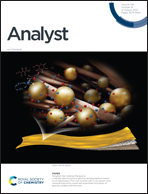A plasmonic fluorescent ratiometric temperature sensor for self-limiting hyperthermic applications utilizing FRET enhancement in the plasmonic field†
Abstract
Nanoparticle mediated photo-induced hyperthermia holds much promise as a therapeutic solution for the management of diseases like cancer. The conventional methods of temperature measurements do not measure the actual temperature generated in the vicinity of the nanoparticles during illumination. In contrast, nano temperature sensors built on hyperthermic nanoparticles can relay local temperatures around the nanoparticles during thermal induction. In this study, we present a core shell construct consisting of a plasmonic core and a silica shell encapsulating a FRET pair of organic dyes for such application. The plasmonic core imparts photo-induced hyperthermic properties to the nanoconstruct, while the fluorescent shell enables ratiometric sensing of temperature. We see that even at a low dye encapsulation concentration, the shell displays a linear ratiometric fluorescence response to temperature and high energy transfer between the dye pair. Interestingly, Monte Carlo simulations, without considering the plasmonic core, show that the energy transfer in the system should be much smaller than that observed, confirming plasmon enhancement in the FRET energy transfer. We also show the ratiometric temperature measurement using these particles during photoinduced hyperthermia. This study suggests the use of plasmonic nanoparticles in the next generation “self-limiting” photothermal therapy.



 Please wait while we load your content...
Please wait while we load your content...